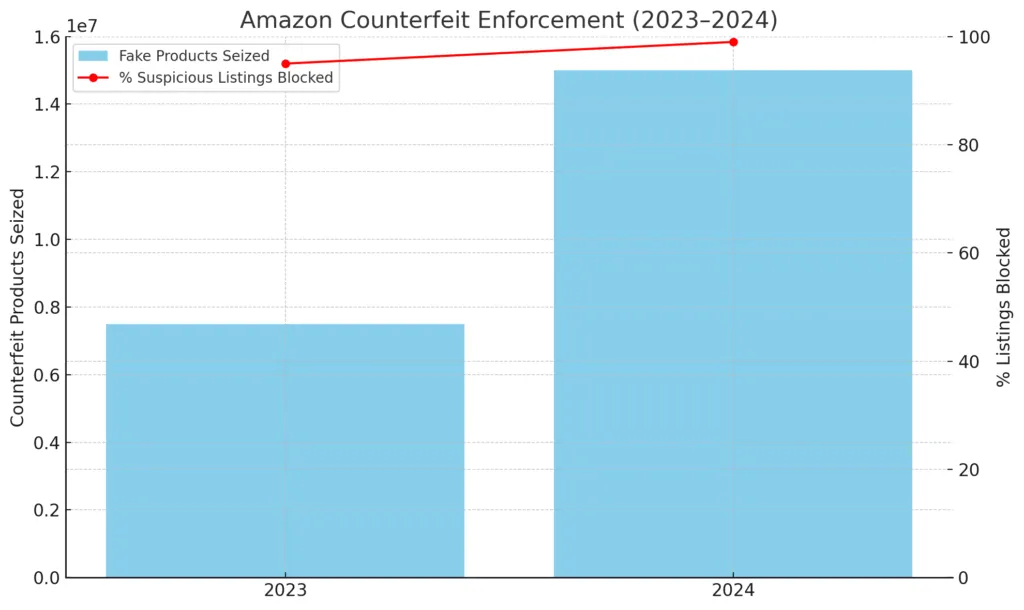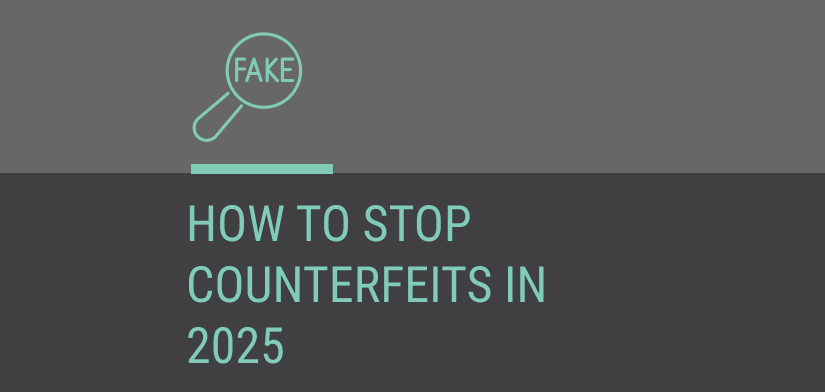Marketplace Brand Protection: How Stop Counterfeits in 2025
The rise of eCommerce has transformed how brands connect with consumers, but it’s also opened the floodgates to digital threats. Global online retail sales are expected to reach $4.1 trillion in 2024, with platforms like Amazon now accounting for over a third of the U.S. market. At the same time, marketplaces such as eBay, Temu, TikTok Shop, and Shein are surging in popularity, offering new revenue streams—and new risks.
As marketplace growth accelerates, so does the sophistication of counterfeiters, impersonators, and unauthorized sellers. Powered by AI and automation, these bad actors are moving faster than ever—creating fake listings, cloning stores, and exploiting trusted platforms to deceive consumers.
For eCommerce and marketing teams, marketplace brand protection is no longer a nice-to-have—it’s mission-critical. Whether you’re in fashion, healthcare, electronics, or cosmetics, your brand’s reputation, revenue, and customer trust are on the line.
In this post, we’ll break down the key threats facing brands today and offer practical strategies for building a strong marketplace defense across Amazon, eBay, TikTok Shop, and beyond.
Why Marketplace Brand Protection Should Be a Priority
There is no question that fraud on online marketplaces has evolved dramatically. According to the International Chamber of Commerce, counterfeiting and piracy could cost global businesses $4.2 trillion by 2025. Amazon alone removed over 7 million counterfeit listings in 2023. Meanwhile, eBay continues to battle brand impersonations and fake listings at scale.
In 2024, Amazon significantly ramped up its fight against counterfeits, seizing and properly disposing of over 15 million fake products across its global marketplace—more than double the amount from the previous year. Powered by advanced AI and machine learning, Amazon’s systems were able to block over 99% of suspicious listings proactively, often before brand owners had a chance to report them. This marks a major step forward in automated enforcement and underscores the growing importance of AI-driven brand protection at scale.

On BrandShield’s platform, we have detected many ways in which scammers now use AI to create hyper-realistic fakes, complete with stolen photos, fake reviews, and cloned storefronts. In the fashion industry, counterfeit handbags can appear within hours of a new product launch. In healthcare, fake medical devices and supplements are not just a reputational threat—they’re a risk to public health and cause damage to brand reputation.
For marketing teams and brand managers, it’s been noted that these attacks dilute brand equity, erode customer trust, and undermine paid campaigns. Whether it’s brand abuse on eBay or phishing scams via fake customer service on social media, the damage can be immediate and widespread.
Curious how your brand is exposed across marketplaces? Request a free marketplace brand protection scan from BrandShield to see what’s out there.
The Most Common Forms of Marketplace Brand Abuse
Modern counterfeiters don’t just sell knock-offs—they create entire ecosystems of deception. Here are some key red flags to watch for:
- Trademark Infringement: Scammers copy logos, slogans, and names to mislead shoppers.
- Counterfeit Listings: Fake or non-existent goods appear as genuine, using stolen images and brand descriptions.
- Visual Misrepresentation: Fraudsters Photoshop logos or branded packaging onto generic products to trick buyers.
- Account Impersonation: Entire stores are cloned, complete with fake customer support and reviews.
- Gray Market Sales: Unauthorized third parties sell genuine goods without permission, creating pricing inconsistencies and support issues.
These tactics are especially rampant on platforms like Amazon, eBay, AliExpress, and even fast-growing players like Temu and TikTok Shop.
How Social Media Accelerates Brand Abuse
With over 2.71 billion people shopping online across marketplaces and social media stores, scammers have more opportunities than ever. Platforms like Instagram, Facebook Marketplace, and TikTok aren’t just for discovery and research, they have become critical sales channels for most brands.
But with that comes new risks. Scammers impersonate brands and even customer service teams, often responding to real customer complaints and redirecting users to phishing pages. Back in 2022 alone, PayPal shut down 4.5 million fraudulent accounts after identifying widespread abuse and these numbers are only increasing.
Strong social media monitoring is essential—not just for reputation, but to prevent these scams from hijacking your brand’s digital voice.
Marketplace Watch: Your First Line of Defense
Scammers thrive in environments where no one is watching. That’s why real-time marketplace brand protection is critical for eCommerce operations. Your strategy should include:
- AI-powered marketplace scans for listings that misuse your name, imagery, or IP
- Takedown automation to rapidly remove counterfeit listings
- Cross-platform threat correlation to track recurring offenders across marketplaces in different regions.
eBay remains a top sales channel—but also a hotspot for unauthorized listings and counterfeit goods. In 2023, it accounted for $35 billion in U.S. marketplace sales, second only to Amazon.
On eBay, brand abuse often takes the form of:
- Used products sold as new
- Authentic goods sold outside of authorized channels
- Counterfeit items mixed with legitimate inventory
This makes brand protection tricky. Marketing teams must regularly audit listings, enforce MAP policies, and use tools that help flag sellers violating brand guidelines. BrandShield’s AI models are trained to detect these nuanced threats and cluster them together by origin or campaign to find similar threats. .
Monitoring Amazon: Where Scale Demands Automation
Amazon remains the dominant eCommerce force, but its open marketplace structure makes it a magnet for counterfeiters. The platform has made progress with Brand Registry and Project Zero, but brands still face:
- Fake resellers are undercutting pricing
- Listings hijacked with incorrect or misleading content
- Delays in enforcement without proof of IP ownership
For growing eCommerce teams, this means proactive monitoring is a must. Brand protection on a platform like Amazon isn’t just about enforcement—it’s about continuous visibility and fast reaction time.
Real Threats from Emerging Marketplaces
As new marketplaces rise, fraudsters adapt quickly. In Southeast Asia alone, scammers generated an estimated $37 billion in illicit gains in 2023. Platforms like Tokopedia and Bukalapak still struggle with slow takedown systems and repeat offenders. Meanwhile, platforms like Temu and AliExpress face scrutiny for enabling global counterfeit trade.
These sites attract global shoppers with aggressive pricing and logistics, but inconsistent IP protection puts your brand at risk. A robust marketplace protection strategy should cover both established and emerging platforms.
What eCommerce and Marketing Teams Can Do
You don’t need to fight these threats alone. A strategic approach combines in-house awareness with outsourced expertise.
- Educate Your Teams
Train marketing, customer service, and eCommerce teams to spot common scam patterns. Hold quarterly reviews of new fraud tactics. - Audit Your Digital Presence
Run monthly sweeps of Amazon, eBay, TikTok Shop, and others for unauthorized sellers, clones, or fakes. Identify your problematic marketplaces. - Monitor Social Media Activity
Use tools like BrandShield’s social media monitoring to track impersonations and mentions of your brand. - Leverage IP Assets
Ensure trademarks and copyrights are up to date and registered in key markets in all operating regions. - Partner with Experts
BrandShield’s platform combines AI-powered digital risk protection, deepfake image recognition, and 24/7 monitoring capabilities with legal expertise—delivering over 98% takedown success across marketplaces and social media.
Final Thoughts: The Cost of Inaction
Brand abuse on eBay, Amazon, and social platforms isn’t just an IP issue—it’s very quickly become a marketing and revenue problem. Every counterfeit listing drains customer trust and brand revenue. And once a scam goes viral, damage control becomes exponentially harder.
With fraud growing fast, we have seen that there is simply no time to wait.
Whether you’re managing an online storefront or leading a global eCommerce strategy, marketplace brand protection is your brand’s digital insurance policy.
Brand abuse moves fast — and so should your response.
👉 Get your free brand scan or book a strategy call with our marketplace protection team.
